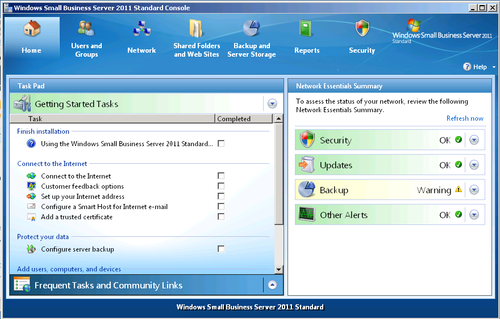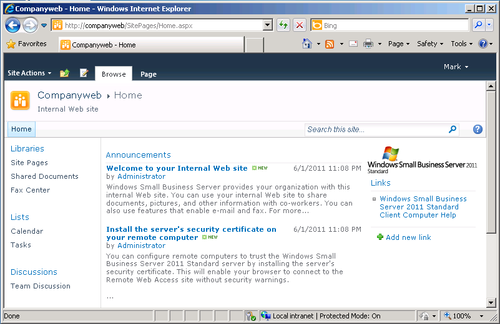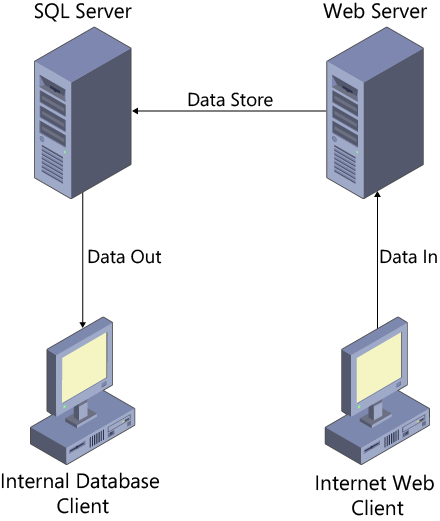Windows SBS includes a number of Microsoft server
applications; some are retail products, and others are available as free
downloads. Even in the case of a free product, however, you benefit by
obtaining it with Windows SBS in several ways, including ease of
installation and automated configuration.
Windows SBS 2011, as shown in Figure 1,
is designed for use on a network that consists of 1 server and up to 75
workstations. One primary server performs all the infrastructure
services required for the operation of the network. The Premium Add-On
(available as a separate product) provides the ability to install a
second server and run line-of-business (LOB) applications.

The following sections examine each of the components included in the Windows SBS product.
1. Windows Server 2008 R2
The Windows Server 2008 R2 operating system is a fundamental component of the Windows SBS package; it provides the environment in which all the other components run. Windows SBS
2011 includes Windows Server 2008 R2 Standard, with all the components
found in the retail and original equipment manufacturer (OEM) operating
system products.
Windows Server 2008 R2
includes a large collection of applications and services, packaged as
roles, many of which Windows SBS relies on to provide the infrastructure
that your network needs to run. The biggest difference between Windows
SBS 2011 and a standalone version of the operating system is that SBS
automatically installs and configures many of these roles for you, while
with a standalone Windows Server 2008 R2 product you must add the roles
that define the functions you want the server to perform.
For example, to configure the
server to function as a domain controller, you must install the Active
Directory Domain Services (AD DS) role
and then run a wizard to promote the server. When you install Windows
SBS, the setup program adds the AD DS role for you, along with many of
the other available roles, and configures them as needed. In a large
business environment, this automatic configuration would not be
practical because there are likely to be multiple servers on the
network, with each one dedicated to a few specific roles. On a small
business network with only one infrastructure server, however, SBS
installs all the roles, services, and applications required for a
typical network. You can, of course, disable elements that you do not
need after the installation, or install additional roles as needed (with
some limitations).
Another big difference
between the Windows SBS version of Windows Server 2008 R2 and the
standalone versions is the inclusion of the Windows SBS Console tool, shown in Figure 2.
This console, not included in the standalone versions of Windows Server
2008 R2, provides a central administration tool for all the
applications and services installed with Windows SBS. This console also
insulates the relatively inexperienced administrator from many of the
more advanced, yet infrequently used configuration settings provided by
the standard Windows Server tools. As you gain experience with Windows
SBS, or if you are already an experienced Windows administrator, you
still have access to all the familiar tools included with Windows Server
2008 R2.
The version of Windows Server 2008 R2 in Windows SBS 2011 includes a five-pack of the SBS 2011 Client
Access License (CAL) Suite. This enables up to five users or devices to
connect to the server and access its services. To support more than
five users, you must purchase additional CALs. Unlike the CALs supplied
with and sold for Windows Server 2008 R2, which provide clients with
access only to the server, the Windows SBS CALs provide clients with
access to all the applications included with the product. With Windows
SBS, you do not need to purchase separate licenses for Microsoft Exchange Server clients; the SBS 2011 CAL Suite provides client access to Exchange Server 2010 as well as Windows Server 2008 R2.

2. Exchange Server 2010 Standard SP1
Email
has become a staple of business communications, and Exchange Server
2010 is Microsoft’s flagship email messaging product. Exchange Server
provides an organization with internal email messaging, plus incoming
and outgoing Internet email access. The mail is stored on the server so
that users can access their messages from different computers and with a
variety of client interfaces, including Microsoft Office Outlook on the
desktop; Outlook Web Access (OWA), a web-based interface that provides
access from any computer, inside or outside the enterprise; and even
mobile devices, such as smart phones. In addition to email, Exchange
Server also provides storage for calendar data, contacts, journals, and
to-do lists, all of which users can share over the network, creating a
variety of collaborative business solutions.
Exchange Server is a
complex product, with many features and settings. However, in Windows
SBS 2011, the main product installation process includes Exchange 2010
along with the Service Pack 1 (SP1) release. In addition, the critical
configuration settings for the Exchange Server application and access to
parameters for individual users are integrated into the Windows SBS
Console, simplifying the administration process considerably. As with
Windows Server 2008 R2, though, more experienced administrators can use
the standard tools supplied with Exchange Server, such as the Exchange
Management Console.
3. SharePoint Foundation 2010
As part of its default setup procedure, Windows SBS 2011 installs Internet Information Services (IIS),
the web server application included with Windows Server 2008 R2, on the
primary server. Windows SBS uses IIS to host a number of websites for
various administration purposes, such as client deployment and update
distribution. Windows SBS also creates a default company website, as
shown in Figure 3, using Microsoft SharePoint Foundation 2010 and the Windows
Internal Database feature of Windows Server 2008 R2. SharePoint
Foundation is a free, web-based collaboration environment that enables
users to create, share, and edit files; schedule calendar appointments;
create task lists; and participate in forum-style group discussions.

SharePoint Foundation 2010 requires a SQL
Server database to store user files, messages, and other information.
Windows Server 2008 R2 includes a feature called Windows Internal
Database, essentially a special-purpose implementation of SQL Server,
which SharePoint Foundation uses by default. Do not confuse the SQL
Server implementation in the Windows Internal Database with the
full-featured one supplied with Windows SBS Premium Add-On. Windows SBS
2011 includes SharePoint Foundation 2010 and installs it on the primary server using Windows Internal Database. However, if you are running the Premium Add-On, it is possible to configure SharePoint Foundation to use the full SQL Server 2008 R2 Standard product on your secondary server to host the database.
4. Windows Server Update Services 3.0
Regular operating system
updates are a fact of life for all Windows users and administrators.
Microsoft releases security updates, bug fixes, and feature enhancements
on a regular basis, and Windows SBS uses Windows Server Update Services
(WSUS) 3.0 to automate the process of downloading new updates and
distributing them to the computers on the network.
By using a central
distribution point, you can conserve bandwidth on your Internet
connection by downloading updates once instead of letting each computer
download its own copy. WSUS also enables administrators to evaluate and
test the updates and then decide whether to deploy them to the rest of
the network.
5. SQL Server 2008 R2 Standard for Small Business
SQL Server 2008 R2 is a
relational database manager application that you can use to deploy LOB
applications designed to run within the environment that it provides.
SQL Server 2008 R2 Standard for Small Business is included only with the
Windows SBS 2011 Premium Add-On product, along with a second copy of
Windows Server 2008 R2 to install on a second server.
Note:
Unlike Windows SBS 2008
Premium, the Windows SBS 2011 Premium Add-On includes only 64-bit
versions of Windows Server 2008 R2 and SQL Server 2008 R2 Standard
because Windows Server 2008 R2 is available only for the 64-bit
platform. Therefore, the secondary server on a Windows SBS 2011 network
must be 64-bit.
The primary
server in a Windows SBS 2011 deployment performs a large number of
functions, including domain controller, Exchange Server, and web server.
Adding SQL Server to the mix would likely overtax the server’s
resources, so the Windows SBS Premium Add-On provides the software for a
second computer running Windows Server 2008 R2, which runs SQL Server
2008 R2 and any applications that require its database services.
SQL Server is a
database manager, which means it provides the services that applications
need to store data and supply it to clients. Structured
Query Language (SQL) is a language that applications use to send
instructions to the database manager. The instructions enable the
database manager to add information to a database stored on the server
or retrieve specific information and supply it to another application.
A typical
SQL Server implementation in a Windows SBS environment might consist of
a web application running on the primary server along with a website
that is accessible from the Internet. Users accessing the website supply
information via a form, and the web server stores the information in a
SQL Server database on the secondary server. Later, internal users
access the information in the database using an intranet web interface
or a dedicated client, as shown in Figure 4.

For clients on the Windows SBS network to access the SQL Server applications, they must have a special license called the CAL
Suite for Premium Users/Devices. This license is more expensive than
the standard CAL Suite, but only the clients that access the database
require it. If, for example, some users need access to the SQL
Server databases and some do not, you can purchase CAL Suite Premium
only for those who need it and then use the less expensive, standard CAL
Suite for those who do not.